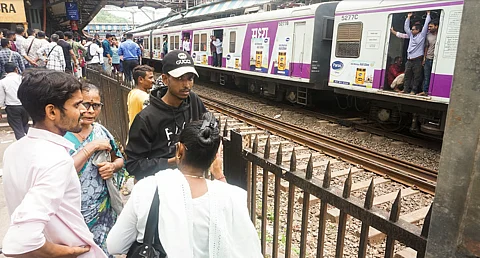

The morning of June 9th began like any other for thousands of Mumbai's suburban train commuters. Peak hour crowds pressed against train doors, passengers hung from footboards, and the familiar routine of survival played out across the city’s overburdened rail network.
Then, near the Diva-Mumbra section in Thane district, momentum intervened with devastating finality.
As two trains passed each other at high speed around a curve, the sudden jerk sent eight passengers tumbling from overcrowded compartments.
Four died, including a Government Railway Police constable, and nine were injured.
For Abin John and Parth Dangat, both college students who navigate these same routes daily, the tragedy felt less like a shocking accident and more like an inevitable outcome of a system pushed beyond its breaking point. Their perspectives, shaped by years of precarious commutes, reveal a population that has learned to normalise what should be unthinkable.
Abin, a third-year student at Pillai College Panvel who travels from Airoli, describes a journey that transforms dramatically with the clock. His noon departure finds relatively empty trains, but the evening return becomes a test of endurance.
“During this return journey, it's insanely crowded, so packed that you can't even see your feet,” he explains matter-of-factly.
“It could’ve been anyone,” said Parth, a final-year engineering student at VESIT, who boards from Thane every morning. “That same platform, that same chaos, I’m there every day.” He describes his commute to Chembur via the Central line as an exercise in endurance. “Most mornings, I’m packed into the train with barely space to breathe. Delays are the norm. And if I miss the direct train, I have to juggle multiple connections, with crowd pressure weighing down every step.”
The statistics underlying their experiences are grim. Mumbai's suburban network operates at what officials euphemistically term “super dense crush load” levels, cramming 14 to 16 people per square meter during peak hours.
On average, six to ten deaths occur daily from falls or crushes on this network.
What makes these numbers particularly haunting is how they have been absorbed into the city's collective consciousness as the price of mobility.
Both students speak with unsettling clarity about the omnipresence of danger. “People hanging from the doors, slipping, or even falling off it's not rare at all,” Abin observes. “It’s so common that it almost stops feeling shocking, which is the scariest part.”
This desensitisation, he explains, becomes a psychological defense mechanism.
You stop reacting to threats that have become routine, because constant fear would be unbearable.
The government's response to Monday’s tragedy followed a predictable pattern. Chief Minister Devendra Fadnavis announced compensation of five lakh rupees to bereaved families. The Railways Ministry promised automatic door-closing systems for all non-AC suburban trains by January 2026, along with enhanced ventilation.
The rail minister held emergency meetings, opposition leaders demanded resignations, and the familiar cycle of reactive governance began anew.
Yet for those who live this reality daily, these promises feel inadequate. Abin questions whether automatic doors will even work, predicting that desperate passengers will find ways to block them during rush hours.
“Even if the doors do stay shut, the overcrowding inside is so intense that better ventilation alone won't help people will still feel suffocated,” he argues.
Parth echoes this skepticism, acknowledging that while automatic doors and better ventilation might help “to an extent,” they don't address the fundamental issue of overcrowding. “Unless the frequency of trains increases and the pressure on each compartment is reduced, these changes will just be surface-level fixes.”
Their analysis reveals a deeper truth about Mumbai's transportation crisis. The problem is not merely technical but systemic, rooted in decades of infrastructure development that has failed to keep pace with urban growth.
The Mumbai Urban Transport Project, despite years of implementation and substantial funding, has yielded little visible improvement for daily commuters.
Both students express confusion about where allocated budgets actually go, highlighting a transparency gap that leaves those most affected by the system with little understanding of its governance.
The mental toll of this daily navigation between safety and necessity cannot be understated. Parth describes existing in constant “survival mode,” perpetually calculating “where to stand, how to balance, how to avoid being pushed.”
This hypervigilance becomes second nature, but it represents a profound failure of urban planning when citizens must develop combat-level awareness simply to travel to work or school.
Perhaps most troubling is how this crisis has been normalised across generations. Both students acknowledge that meaningful change seems to occur only in response to tragedies, when temporary media attention forces official acknowledgement of problems that persist year-round.
Abin notes that “this issue only seems to get attention when there's a tragedy when someone dies. That's when it makes headlines. Otherwise, it just becomes part of the daily struggle that everyone accepts.”
What follows June 9th's accident is expected to mirror a familiar cycle: brief outrage, official promises, and then a return to the status quo. The fundamental structural issues, adequate train frequency, platform capacity, and long-term urban planning, will remain unaddressed. And students like Abin and Parth will continue their daily calculations of risk and survival, their voices offering testimony to a crisis that has been allowed to fester for far too long.
The real tragedy of June 9th was not just the four lives lost, but the millions of journeys that continue to unfold under conditions that make such losses inevitable.
Until that fundamental reality changes, Mumbai's trains will remain what one commuter described as “gas chambers on rails,” and students will continue to measure their education not just in marks scored, but in dangers survived.
